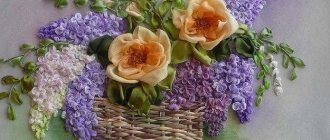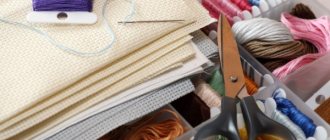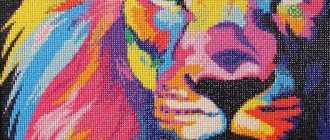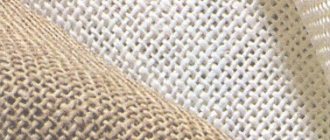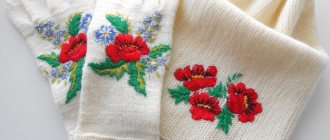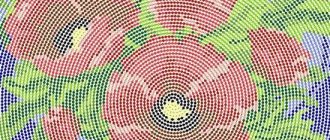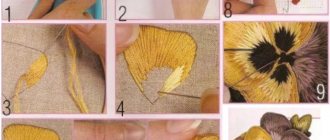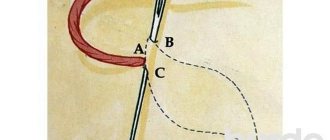Rating: 4.75/5 (4)
An essential quality of a real lady is her ability to do needlework. One of the most popular types of needlework is cross stitch. The roots of this craft go deep into primitive culture. Initially, the cross was used for sewing clothes, later they began to decorate clothes with ornaments and create real works of art - embroidered canvases.
Embroideries from different countries, eras and peoples differ in their ethnic characteristics. But this only emphasizes the versatility of this type of needlework. We have collected for you different cross stitch patterns that will suit both experienced craftswomen and beginner needlewomen, and completely free of charge.
Features of the cross stitch technique
There are many types of embroidery, but the cross stitch technique today is the simplest and most effective way to create beautiful canvases. Learning to cross stitch is easy. The main thing is to decide on the design and find a diagram that matches it.
For embroidery, canvas is used - a special fabric marked with a checkered pattern, made from:
- cotton, linen (used for making ornaments for clothes, paintings);
- Stramin (with a large check, used for embroidering carpets, tapestries or pillows);
- plastic (made from vinyl, good for crafts, cards or decorations).
The canvas also differs in color, it can be white, black, red or marble. For the design, floss threads are used, selecting their colors depending on the pattern and embroidery pattern. For beginners, in sewing stores you can find cross stitch kits with a marked pattern, threads of the required colors, needles and hoops.
What cross stitch patterns are suitable for beginners?
Cross stitch can be complex and multi-colored. Experienced craftsmen recommend that beginners take their time when doing major work. First you need to work with small circuits. It is advisable to start with simple, monochrome designs, and, without being distracted by changing thread colors, learn how to perform stitches correctly.
When the crosses turn out smooth and neat, you can try low-color schemes, in which you can use 3-4 different shades. At this stage, the master will learn to count cells and select colors.
It is better to use a canvas with a printed pattern at the third stage of training. When the craftsman can make even stitches and quickly match the colors of the threads to the corresponding cells, working with such fabric will become even easier.
Black and white patterns, monochrome cross stitch
Owl
This author's cross stitch pattern with an image of an owl is suitable for experienced craftswomen. The eyes of an owl can be made using a French knot in embroidery, so the work will be more expressive.
Step-by-step recommendations:
- It is convenient to carry out the scheme on Aida 16 canvas;
- pattern size – 250x275 crosses;
- you need a canvas measuring 40x43 cm;
- use DMS threads in 17 colors;
- You can choose the color of the threads from the picture;
- the main work is done with a regular cross;
- It is recommended to use a 3/4 cross along the edge of the owl.
A cup of coffee
This black and white cross stitch pattern is easy to make but still beautiful and effective. Suitable for beginners.
Step-by-step recommendations:
- pattern size – 110x120 cells;
- to complete the drawing you will need Aida 14 canvas;
- take a canvas measuring 26x28 cm, taking into account the allowance for the edges;
- The pattern is small, we calculated an allowance of 3 cm on each side;
- use floss threads of two colors according to the picture;
- try to fix the thread from the inside with a loop, do not leave any knots;
- Do not pull the thread too tightly when embroidering, otherwise the design will come out skewed.
Dancing girls
This is a monochrome painting, recommended for experienced needlewomen.
Step-by-step recommendations:
- pattern size – 200x185 crosses;
- For embroidery, a regular cross is used;
- Aida canvas size 14 including frame – 46.3x43.6 cm;
- an allowance of 5 cm is calculated on all sides;
- DMS thread can be taken in any color;
- The pattern looks especially good in black or coffee.
Notes
This monochrome cross stitch pattern can be used to decorate pillows. Even a beginner can handle it.
Step-by-step recommendations:
- pattern size – 100x98 crosses;
- take canvas Aida 14;
- make markings on a canvas measuring 24.2x23.8 cm, taking into account the allowance;
- we calculated the frame to be 3 cm on each side;
- floss thread needs one color, depending on your preferences;
- a pattern made with dark-colored thread looks good;
- It is preferable to use black, indigo, blue, burgundy, cherry or dark green.
Little predator
A cute picture for experienced craftswomen.
Step-by-step recommendations:
- pattern size – 150x200 crosses;
- take Hades canvas 14;
- the canvas should be 37x46 cm in size, including the frame;
- we calculated a 5 cm frame around the perimeter of the work;
- use DMS threads in 9 colors;
- colors can be easily matched to the pattern.
Miniature and small pictures and patterns for cross stitch
Small cross stitch patterns vary in complexity, but are suitable even for beginner needlewomen.
Grape ornament
This cross stitch pattern can be used to decorate towels. This embroidery looks good on clothes.
Step-by-step recommendations:
- width of the pattern – 42 crosses;
- It is recommended to perform the scheme on Aida 14 canvas;
- take the width of the canvas 11.6 cm, taking into account the allowance for the edges;
- in the ornaments we made an allowance of 3 cm at the bottom and top;
- adjust the length of the canvas depending on the width of the intended towel;
- for embroidery, use DMS threads of two colors;
- the best color combination is red and black;
- For a high-quality design, sew up the space between the elements of the ornament with crosses made with white threads.
Ornament with corner
Sometimes you need to decorate the frame with an ornament or trim the towel around the perimeter. For these purposes, the following scheme, made in Russian folk motifs, is perfect.
Step-by-step recommendations:
- width of the ornament – 70 crosses;
- there is a corner element;
- to complete the work you will need Aida 14 canvas;
- take a canvas 18.7 cm wide, taking into account the allowance for the edges of the ornament;
- we have provided an allowance of 3 cm at the bottom and top of the ornament;
- for embroidery, use floss threads of two colors;
- the pattern looks great when combined with dark blue and light blue threads;
- To make the work look decent, we recommend sewing up the spaces between the colored elements of the ornament with crosses made of white threads.
Butterfly
The design can be used to decorate postcards or souvenirs. The cross stitch pattern for a beautiful butterfly is quite simple, anyone can do it.
Step-by-step recommendations:
- picture size – 130x110 crosses;
- for work you will need Aida 16 canvas;
- use a canvas measuring 26.6x23.4 cm, taking into account the allowance;
- The pattern is small, we have provided an allowance of 3 cm on each side;
- for embroidery use DMS threads in 7 colors;
- All colors can be easily matched to the drawing.
Hearts
These cute hearts will be a great decoration for a postcard or a stand-alone gift for Valentine's Day. The drawing is simple, any novice craftswoman can handle it.
Step-by-step recommendations:
- picture dimensions – 47x47 crosses;
- for work use Aida 11 canvas;
- you need a canvas measuring 16.9x16.9 cm, taking into account the allowance;
- The picture is small, an allowance of 3 cm is calculated for the frame;
- you will need floss threads in 4 colors;
- You can choose colors from the picture, the gamma can be changed as desired.
Snowflakes
This cross stitch pattern can be classified as New Year's ornaments. It’s quite possible to embroider pillows with such snowflakes. The pattern is simple in execution, but looks very impressive, especially on colored canvas.
Step-by-step recommendations:
- take Hades cloth 14;
- the picture shows 5 snowflakes of different sizes;
- size of the upper left: 37x37 crosses, occupies an area of 6.7x6.7 cm on the canvas;
- two lower snowflakes measuring 35x35 crosses will occupy squares of 6.3x6.3 cm;
- two small snowflakes measuring 17x17 crosses will occupy squares measuring 3.1x3.1 cm;
- White DMS thread is used for embroidery;
- You can use colored canvas.
Beautiful cross stitch: small patterns
When creating such embroideries, several types of stitches are used to fill the cells:
- half-cross;
- tapestry stitch;
- cross and others.
Two schemes are used: conventional and Danish. In the first case, first embroider a cross in one square and then move on to the next one. In the second, the entire pattern is made with diagonal stitches in one direction, then you need to embroider the pattern with perpendicular stitches.
Before you begin, you need to consider the following questions:
- Select the fabric on which the embroidery will be done.
- We need to think through the plot. It must be appropriate for where the product will be used.
You might be interested in this All about hoops for cross stitch and bead embroidery: we do it ourselves
When creating small cross stitch designs, the patterns can be done in black and white or color.
Butterfly image
Before starting work, prepare everything you need, including tools, materials and a design for future embroidery.
Polar bear from the wild
This option is well suited for children's stories. In addition, you need to take into account that the embroidered polar bear is a symbol that has esoteric meaning. It simultaneously denotes strength and indestructible power, and protects against negative energy.
Mini polar bear embroidery
You can make a decorative item with such embroidery and place it in the office. Such a talisman will promote career growth. This plot will look beautiful if used for home decor. It can be used as a New Year's motif.
Mini-plots garden
Garden scenes with an unpainted field look light and airy. Drawings of plants, snails, birds and flowers create an atmosphere of harmony and carefree. They are suitable as decorations used in home decor. These can be images of plants or abstract patterns.
Garden plots
These stories will look good in a children's room. They are suitable for decorating clothes or creating story brooches. Micro-embroidery will allow you to add a new accent to already familiar clothes. The depiction of simple garden images in high-quality execution can express a special meaning and create interesting shades of meaning.
Lovebirds - wedding doll
Images of lovebird dolls represent an ancient Slavic amulet.
For your information! It is believed that lovebirds were given to people by the goddess Makosh, the patroness of the family hearth.
Such embroideries are perfect for a variety of types of wedding symbols.
Lovebirds
Mini embroidery of lovebirds is a suitable symbol for home decoration. She has the power to maintain relationships and ward off unkind glances.
Flower card
Images of flowers are a symbol of beauty in any country. Such mini-embroideries have a universal meaning. They are suitable for both clothing decoration and home decor. It is appropriate to decorate a child’s room with such embroideries, placing them on furniture, walls or creating decorative elements. You can place them on children's clothing or accessories.
Flower cards
Flowers look good embroidered on children's clothing or made on women's accessories (for example, handbags or cosmetic bags) or on objects that the child uses. By choosing suitable flowers, the craftswoman can express various artistic ideas.
You might be interested in How to make embroidery on a baseball cap or cap yourself
Warmth of palms - bunny
This plot symbolizes warmth and kindness. It is a symbol that will remind the child of the love of mom and dad and the warmth of home comfort. This mini embroidery is suitable for decorating a children's room and will look good as one of the symbols of family well-being.
Warmth of palms - bunny
The image of a small bunny in the palms creates a feeling of human warmth, symbolizes the strength of the family and carries positive energy.
Garden cards
The use of postcards with embroidery is not only a beautiful decorative item, but also a work of art that expresses the creative intent of the master. The garden theme combines modesty and simplicity with the versatility of nature symbols.
Garden cards
The use of mini-embroideries with motifs in the form of images of plants and fruits is well suited for home decor.
The simplest patterns for embroidery
They combine the beauty of nature and symbols of well-being.
Animals and plants
Here we have selected several diagrams depicting animals, birds and flowers, varying in complexity and size.
Cute sheep
Even a novice needlewoman can handle this small, cheerful drawing.
Step-by-step recommendations:
- picture size – 50x50 crosses;
- you will need Aida 14 canvas;
- take a canvas measuring 15x15 cm with a frame;
- the dimensions of the canvas take into account an allowance of 3 cm on each side of the pattern;
- select floss threads according to the picture;
- in total you will need 9 colors.
Firebird
This wonderful bird will decorate any pillow. The drawing is quite large, but novice needlewomen can handle it - it is not complicated.
Step-by-step recommendations:
- pattern size – 96x158 cells;
- the work looks good on Aida 14 canvas;
- for work you will need a canvas measuring 23.5x34.7 cm, taking into account allowances;
- The picture is relatively small; a 3 cm frame is taken into account on each side of the picture;
- DMS threads are required for operation;
- use 6 colors selected from the picture;
- The color range can be changed to suit your taste.
Predatory fox
This work is quite complex and is recommended for skilled needlewomen.
Step-by-step recommendations:
- painting size – 250x300 crosses;
- We recommend using Aida 16 canvas;
- use a piece of canvas measuring 50.6 x 42.2 cm with allowances;
- The work is large, the dimensions of the canvas include an indentation of 5 cm on each side;
- use floss threads 120 colors;
- Choose colors according to the picture.
prancing horse
This is a very beautiful cross stitch pattern. Recommended for experienced needlewomen.
Step-by-step recommendations:
- embroidery size – 300x236 crosses;
- A drawing made on Aida 16 canvas turns out well;
- take a canvas measuring 57.6x47.4 cm with a frame;
- the painting is quite large, the frame allowance is 5 cm on each side;
- you will need DMS threads in 75 colors;
- Select all colors and shades according to the drawing.
Roses
This is a pattern of roses for cross stitch of medium difficulty.
Step-by-step recommendations:
- pattern size – 200x155 crosses;
- take Aida 16 canvas as a basis;
- for the diagram, use a canvas measuring 41.74x34.6 cm, taking into account the frame;
- we took into account a 5 cm indentation on each side of the picture;
- take floss threads 60 colors;
- All colors and shades can be easily selected from the picture.
Required materials for cross stitch
To start small cross stitch patterns, you need to prepare your fabric and accessories. If you plan to make a design on clothes, tablecloths or linen, the canvas is tucked into a hoop and starting with a flower or other design. When planning to embroider for decoration, vinyl or Aida canvas is best suited for beginners. If it is not possible to use them, you should take any simple fabric with a large weave. Suitable materials for cross stitch include burlap, cotton, linen or canvas. These fabrics have clearly visible small squares, which provide significant assistance when cross-stitching.
You might be interested in Review of the most beautiful patterns for cross stitch
Before starting work on small embroideries, the edges of the fabric must be overcast or secured with glue. Some craftswomen use ribbons for this purpose, which are sewn onto the edges.
The following threads can be used:
- floss;
- metallized;
- tapestry wool;
- melange;
- silk;
- fine wool.
Bouquets of flowers
Please note! The fabric is folded in half to determine the center point of the future design. This will help to position the embroidery correctly on the canvas.
Video with cross stitch master class lessons with patterns for beginners
This video shows the basics. It tells how to make crosses correctly and how to mark the canvas. The lesson uses a ready-made embroidery kit for beginners.
This video shows in detail one of the methods of cross stitching. It demonstrates in detail how to secure the thread using the loop method without turning the embroidery over.
The video demonstrates in detail the “parking lot” cross stitch method. The essence and advantages of the method are described and shown in detail.
The video demonstrates two embroidery techniques: half-cross stitch and tapestry stitch. Shows how to create both types of stitches and how they differ.
This video clearly shows how to embroider with two punctures. It talks about all the details of embroidery and shows how to quickly make half-stitches.
Materials and tools for work
To start cross stitching, you need to purchase the following materials:
- Canvas is a special fabric for embroidery. Its weaving is done in such a way that there are small gaps left for the needle to enter and exit. The canvas can be white or colored. In stores it is sold by the meter, and manufacturers put already cut pieces into embroidery kits.
- The hoop is a special design for tensioning the canvas. They are necessary for convenience, as well as to prevent fabric deformation.
There are round and square hoops. They consist of 2 parts, one is inserted into the other, and a canvas is placed between them. The large part has a screw that can be used to adjust the tension.
Plastic hoops are cheaper than wooden hoops. For large fabrics there are floor structures on legs that allow you to work with embroidery with both hands.
- Embroidery needles They have a rounded tip that will prevent injury, and a long, narrow ear. There is no chance of getting caught between the weaving of the fabric; embroidery needles easily pass through special gaps in the canvas. For each canvas size you need to choose the right needle number.
| Canvas number | Needle number |
| 14 | 22-24 |
| 16 | 24-26 |
| 18 | 27 |
For fabric with non-standard sizes, you need to select the needle number manually. From the edge, through one gap you need to pass the needle. It should go smoothly without getting stuck.
- Floss is a classic type of cotton thread for cross stitch. There are more than 20 well-known manufacturers of these threads. They have a wide range of colors, and embroidery kits contain the required number of skeins, selected by color. For festive projects, there are threads with lurex.
- A marker is needed to mark the canvas into squares for ease of work, as well as to indicate allowances for the hoop. A regular marker will not work, because the rod of a special felt-tip pen is filled with washable ink and after washing, there will be no traces of markings left on the back of the embroidery.
- Scissors are needed for cutting threads and canvas. They should always be kept sharp. It is better to buy a pair of scissors, some small, others a little larger.
Cross stitch for beginners requires a simple set of materials and tools.
There are also other additional materials for embroidery, for example, thimbles, bones for floss and storage kits. You can learn cross stitch without them.
Cross stitch as one of the types of needlework
Cross stitch has always been considered a noble art. Socialite ladies in fashionable houses more than once whiled away their evenings embroidering their work in the company of other needlewomen. Mastery of the embroidery technique has always been considered something high and beautiful and was the responsibility of every noble lady.
Today there are a lot of embroidery patterns for every taste, color, size and any complexity of execution. You can buy embroidery kits, or you can choose any design and use a special program to develop a pattern for embroidery yourself. Share in the comments, do you like to embroider?
